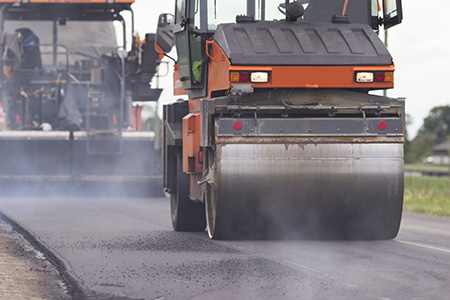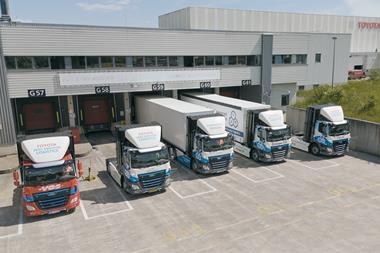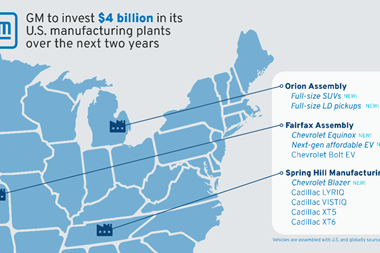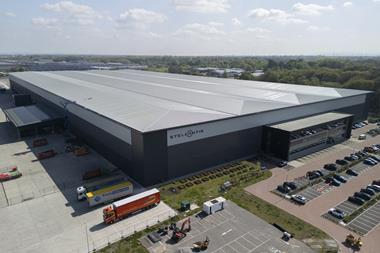Donald Trump’s pledge to lighten the US regulatory load should be music to the logistics industry’s ears, but road and rail providers may have to fight their own corners as and when the changes are rung in
In this story...
“When the dates were originally set, I didn’t intend for our annual meeting to fall around election day,” admits Bill Schroeder, general manager of AHAA. “I didn’t look closely at the calendar, but we decided to hold our fall meeting anyway.”
It might be hard to believe now, but for much of the meeting AHAA members were more concerned with industry issues, such as insurance and driver shortages. However, as polling results started to come in, attendees were glued to their phones. Many were speechless, according to Schroeder, because they were prepared for more of the same in terms of political leadership; in other words, a victory for Hillary Clinton, the Democratic Party candidate.
“The conversation shifted dramatically from auto industry issues to the election and the prospect of new national leadership,” says Schroeder.
Since Donald Trump’s election victory and subsequent inauguration, there have been many questions about how the new administration and Republican-led Congress will affect the economy and trade, including logistics. Trump’s pledges to put “America First”, renegotiate the North American Free Trade Agreement (Nafta), and increase tariffs or impose a ‘border adjustment tax’ to increase the cost of imports, would all have significant impacts on the automotive supply chain.
However, the new president has also committed to deregulation in Washington DC, including, specifically, in the transport and automotive sectors. He has furthermore spoken about a $1 trillion plan to upgrade the country’s transport infrastructure.
The latter policy objectives have captured attention and garnered optimism among the broader freight transport and finished vehicle logistics industries. In his run for the presidency, candidate Trump maintained that regulations were stifling job and economic growth in the US.

[sta_anchor id="1"]“We think we can cut regulations by 75% – maybe more,” Trump told a group of business leaders within days of taking office. Trump also noted recently that the Code of Federal Regulations contains 178,000 pages of rules impacting all sectors of business and government. “This isn’t a knock on president Obama,” Trump said of the regulations. “This is a knock on many presidents preceding me.”
Looking for a changeOver the past decade, many in the US logistics industry have also complained about a growing burden of regulatory requirements, from emissions and fuel requirements to labour and safety controls. There has been a perception among some logistics executives that government agencies often adopt regulations without industry input.
“We want to see the transportation industry included in developing regulations,” says Chris Spear, chief executive officer of the American Trucking Association (ATA), the largest advocacy group representing the trucking industry in the country.
On the highways, for example, truckers have been faced with stricter regulation and oversight. Hours-of-service (HOS) rules for drivers, electronic log requirements and load restrictions have all been proposed in recent years for added safety. More recently, debate continues among Department of Transportation (DoT) regulators around the speed of trucks on highways and interstates. The DoT proposed caps as recently as last autumn to limit speeds for commercial vehicles to 60-68mph (96-110kph).
Executives in the rail freight sector have also pointed to growing regulation. Following a number of fatal rail accidents in the 2000s, a number of measures were put in place by the Railway Safety Improvement Act (RSIA) of 2008 (which preceded the Obama administration), including rules around hours of service, track standards and operating requirements intended to reduce accidents.
Among the safety measures that railways have resisted or struggled to meet has been the RSIA-mandated positive train control (PTC), a series of measures intended to better control and monitor trains using navigational equipment to track all passenger and freight movements by rail. The system was supposed to be in place by the end of 2015, however lawmakers agreed to extend the deadline to the end of 2018.
Subsequently, the Federal Railroad Administration issued a proposal in March 2016 that would require a two-person operating crew for all trains, which many railway companies have insisted is redundant and adds extra cost without increasing safety.
"As of [the day before Trump’s inauguration], rules and regulations proposed by the previous administration were in question. Regulations like ‘hours of service’... were no longer on the table and open for further discussion." - Jason Myers, Norfolk Southern
However, many such rules are now in question.
“As of January 19th 2017 [the day before Trump’s inauguration], rules and regulations proposed by the previous administration were in question,” says Jason Myers, director of operating practices at class one railway Norfolk Southern. “Regulations like ‘hours of service’ and [the requirement to have] dual operators on a train at one time were no longer on the table and open for further discussion.”
[sta_anchor id="2"]According to Myers, the American Association of Railroads has asked its members to provide details on how ‘over-regulation’ has affected them negatively, and about the financial restraints on railways over the last decade. Such information will be considered in the association’s lobbying efforts to influence Congress and the new administration.
Legal resistanceDonald Trump’s new administration has indeed wasted little time in targeting regulations – not to mention in stirring up controversy and opposition. Following early campaign promises, the president signed an executive order at the end of January that commits the government to eliminating two regulations for every new one it enacts.
At the end of February, meanwhile, he issued another executive order that directs federal agencies to establish regulatory task forces that will aim to reduce regulations.
However, as with other executive orders that Trump has issued, the ‘two-for-one’ policy has been challenged in District Court; advocacy groups and unions say the order exceeds the president’s constitutional authority, while many critics point out that the order is arbitrary and vague, as it is uncertain what should be classified as ‘new’ and how regulations to be repealed should be decided. At the time of publishing, no ruling had been made.
While legal battles over regulatory approaches are set to continue, the logistics industry has its own internal battles over the age-old question of how to balance safety and environmental protection with operating efficiency.
On the speed of trucks on highways, for example, the Federal Motor Carrier Safety Administration and the National Highway Safety Administration have proposed lower limits, citing studies that suggest a speed limit as low as 60mph would save up to 498 lives in the US each year.
Transport advocacy groups, however, argue that slower speeds result in more truck traffic on the highways, creating more opportunities for accidents. Trucking company lobbyists also cite the fact that car drivers mostly cause accidents involving commercial trucks and passenger vehicles, not truck drivers. A 2013 ATA study commissioned by the University of Michigan Transportation Research Institute suggested that car drivers were at fault 81% of the time in fatal car-truck crashes.
Trucking companies could spend up to $1.5 billion to implement changes to vehicles that would cap the top speed for vehicles weighing more than 26,000 pounds (11,793kg).
“As an organisation, we respect the need for safety regulations and recognise its importance,” says Bill Schroeder at AHAA. “We realise the importance of industry regulations dealing with safety, drug testing and hours of service. The intent, however, is not to see the industry get burdened with over-regulation.”
The rail industry echoes general concerns over safety on the roads, tracks and railway crossings. Norfolk Southern’s Jason Myers points to efforts by the railways to implement safety standards beyond government-mandated rules – specifically the multi-billion dollar collision avoidance system that class one railways have funded themselves to the tune of $11 billion thus far. “The implementation cost could be as much as $20 billion before the programme is completely funded,” he says.
Myers adds that Norfolk Southern has implemented extensive measures to exceed federal safety regulations, including since the RSIA was passed.
However, logistics industry groups don’t always see eye-to-eye on every major issue or regulation. For example, industry advocacy giants like the ATA endorsed electronic driver logs, but the Owner Operator Independent Drivers Association has vehemently opposed the mandate, citing regulatory overreach and describing it as a measure that would benefit only the larger carriers.
There are also divides between transport modes, with the US rail and truck lobbies often at odds. For example, the rail sector has vehemently opposed efforts by the truck lobby to increase length and weight limits for its equipment.
However, when it comes to more recent regulatory issues – or at least resistance to them – more collaboration seems to have emerged among associations and industry leaders.
“We expect to see a lot more collaboration [on industry regulations and policy] than we’ve seen in past years,” said the ATA’s Chris Spear in a statement regarding easing of regulations impacting transport providers in the US.
Reduced regulation has also been a unifying focus of the Railroad Safety Advisory Committee (RSAC) – a multi-faceted board that collaborates on safety issues – since the new administration in Washington took office.
The RSAC participants consist of representatives from railways, unions, government and manufacturers, and Myers suggests it has been an effective way to provide a unified voice for rail-related regulations.
[sta_anchor id="3"]“The sides don’t always agree,” he admits. “But when it came to easing recent regulatory issues during the recent administration transition, the industry groups were quick to endorse a less regulatory environment.”
 The new administration has promised infrastructure improvements, however it recently proposed DoT cuts
The new administration has promised infrastructure improvements, however it recently proposed DoT cutsWaiting for the concrete to pourAside from deregulation, logistics executives are also looking at Trump’s infrastructure promises with interest, hoping that they could spur job growth and help improve operational efficiency with improved roads, tunnels, bridges, landside and portside upgrades.
A substantial investment into port facilities would probably benefit the automotive supply chain, for example. With major infrastructure improvements already in play in most major US port locations, some hope that the Trump administration’s infrastructure spending plan will supplement the cost of existing port projects already in progress.
For example, at the nine major east coast ports that service the automotive industry, authorities have landside or navigational deepening projects in excess of $10.6 billion already completed or underway in anticipation of the expanded Panama Canal, which opened last June.
However, while pledges to invest in new and to update old infrastructure may generally be something that has bi-partisan support in government and across the logistics industry, the manner in which the spending is done, and where, is likely to prove more controversial. For example, a large increase in privately financed infrastructure supported by larger tax breaks – as the administration has indicated it would prefer – would be likely to lead to a significant increase in toll roads and bridges, and would probably focus only on areas that promised high returns.
Meanwhile, Republican lawmakers have already indicated that they would be unwilling to spend huge sums of public money (not least in the view of other potentially costly political objectives around health care, taxes, the military, immigration and a border wall). While sources at government agencies in Washington have suggested that a new infrastructure plan could be presented as early as this year, it is far from clear when or if it will be enacted, and what form it will actually take.
Furthermore, the Trump’s administration’s proposed budget for discretionary spending, released in mid-March, outlined plans for a $2.4 billion cut from the annual budget of the Department of Transportation, or 13% of its budget. The administration indicated that some of that would be replaced by an infrastructure spending bill.
While uncertainty over trade and broader economic policies is palpable, and much about the Trump administration’s economic and infrastructure plans is still to be revealed, many logistics executives are optimistic. If the administration can lighten the regulatory burden and spur infrastructure investment, many see their companies coming out ahead.
CSX president Clarence Gooden, speaking at a recent supply chain conference in Atlanta, said he was optimistic about Trump. “We are going to have a very good economy in 2017,” he said. “People are going to start spending and buying.”
Others in the vehicle logistics industry are waiting to see whether the new administration will take a truly different approach when enacting new policy. AHAA’s Bill Schroeder points out that there were times recently when even positive changes in legislation were compromised by a lack of understanding of the vehicle logistics sector. For example, the Surface Transportation Reauthorization and Reform Act (known as the FAST act), the Obama administration’s signature infrastructure and transport bill passed at the end of 2015, included provision to increase trailer lengths for car carriers from 75ft to 80ft (22.8 metres to 24.4 metres). However, it did not allow for any increase in weight, meaning that in most cases, trucks cannot load more vehicles per trip.
“Our concern is whether the new administration will look deep into the issues and regulations impacting the [sta_anchor id="4"]transportation industry,” says Schroeder.
(Additional reporting by Christopher Ludwig)
 Norfolk Southern and other transport providers welcomed the appointment of Elaine Chao (pictured being sworn in) as an experienced figure in the role of Transportation Secretary in Donald Trump’s government
Norfolk Southern and other transport providers welcomed the appointment of Elaine Chao (pictured being sworn in) as an experienced figure in the role of Transportation Secretary in Donald Trump’s governmentWhile Donald Trump has faced resistance in confirming some of his Cabinet appointees, the US Senate fast-tracked the approval of Transportation Secretary Elaine Chao, a well-known political entity in Washington. Chao had served in George W. Bush’s Republican administration as Labor Secretary from 2001 to 2008, and was previously chairwoman of the Maritime Administration.
Chao takes on the task of shepherding the administration’s infrastructure plans through Congress and integrating a plan to repair and upgrade America’s highways, bridges, tunnels and port facilities.
While many logistics industry professionals are reluctant to comment at this early stage on many of the new administration’s policies, Chao has generally received praise as a knowledgeable and industry-friendly ally in the transport ecosystem.
“Elaine Chao was a huge win for us,” says Norfolk Southern’s Jason Myers. “She is very well thought of among transportation industry leadership and was the only Bush appointee who stayed in her [Cabinet] role for the full eight years of the president’s two terms.”
Board membersThe Trump administration also has the opportunity to make important appointments to the Surface Transportation Board (STB). When the Interstate Commerce Commission was abolished in the mid-1990s, the STB was established to oversee and regulate issues between road and rail providers and their customers. “The board is equivalent to the FAA for airline regulation, but the STB is not as well known to the general public as the FAA,” says Myers.
Expanded by the FAST act under the Obama administration, the bi-partisan board was recently increased from three to five members, who are appointed by the president and confirmed by the Senate.
Supported by a staff of roughly 150, the STB is part of the US DoT and provides regulatory oversight over all surface carriers, including trucking, rail, pipeline, and public transportation. Along with regulatory authority, the board oversees mergers, rate disputes and customer issues.
The Trump administration has already appointed Ann Begeman – the board’s only Republican – to serve as acting chairman until further board appointees can be nominated and confirmed. Begeman’s term on the STB board expires in 2020.
Currently, the Surface Transportation Board has two open positions, which were not filled by Obama. Transport industry leaders have speculated as to whom Trump might appoint to fill the two board positions. However, with an expanded STB board of Trump nominees, industry analysts anticipate a new era of less government regulation.



































